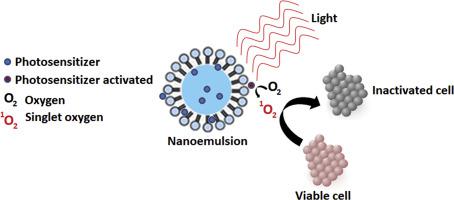Journal of Photochemistry and Photobiology B: Biology ( IF 3.9 ) Pub Date : 2020-08-28 , DOI: 10.1016/j.jphotobiol.2020.112010 Raphaela Aparecida Schuenck-Rodrigues 1 , Luciana Betzler de Oliveira de Siqueira 1 , Ana Paula Dos Santos Matos 1 , Sandro Pinheiro da Costa 1 , Verônica da Silva Cardoso 2 , Alane Beatriz Vermelho 2 , Ana Paula Vieira Colombo 3 , Catarina Amorim Oliveira 4 , Ralph Santos-Oliveira 5 , Eduardo Ricci-Júnior 1

|
Nanotechnology, when applied to PDT's, allows the encapsulation of ZnPc in nanocarriers, producing thus nanoemulsions that permit the use of ZnPc as photosensitizers. The Enterococcus faecalis and methicillin-resistant Staphylococcus aureus (MRSA) are microorganisms present in biofilms which can cause resistant endodontic infections. The objective of this work is the development and characterization of clove essential oil nanoemulsions containing ZnPc. The formulations were developed according to factorial experimental planning and characterized by the determination of the mean drop size, Polydispersity Index (PdI), content, organoleptic characteristics, stability, morphology, cytotoxicity in the dark and evaluation of the photobiological activity. The experimental planning was able to indicate the maximum amount of ZnPc that could be encapsulated in the nanoemulsion while maintaining droplet size <50 nm and PdI < 0.2. The surface plots for the response variables indicated a robust region for the combination of Pluronic® F-127 and clove oil factors. The result of this study was the choice of the nanoemulsion containing ZnPc solution at 5%, clove oil at 5%, Pluronic® F-127 at 10% and will be codified as ZnPc-NE. The nanoemulsion presented a mean diameter of 30.52 nm, PDI < 0.2 and a concentration of 17.5 μg/mL, as well as stability at room temperature for 180 days. TEM showed that the drops are spherical with nanometric size, which corroborates the results of dynamic light scattering. Concerning the photobiological activity, the ZnPc-NE exhibited MIC 1.09 μg/mL for Enterococcus faecalis and 0.065 μg/mL for MRSA (Methicillin-resistant Staphylococcus aureus). ZnPc-NE showed higher photobiological activity than free ZnPc. Besides, cytotoxicity studies showed that blank-NE (nanoemulsions without PS) showed good antimicrobial activity. Thus, clove oil nanoemulsion is an excellent nanocarrier to promote the photobiological activity of the ZnPc against pathogenic microorganisms.
中文翻译:

含锌酞菁锌纳米乳剂在口腔感染治疗中的开发,表征和光生物学活性。
纳米技术应用于PDT时,可以将ZnPc封装在纳米载体中,从而产生纳米乳剂,从而可以将ZnPc用作光敏剂。该粪肠球菌和耐甲氧西林金黄色葡萄球菌(MRSA)是存在于生物膜中的微生物,可引起耐药的牙髓感染。这项工作的目的是开发和表征含ZnPc的丁香精油纳米乳液。根据因子实验计划开发制剂,并通过确定平均液滴大小,多分散指数(PdI),含量,感官特性,稳定性,形态,在黑暗中的细胞毒性和评估光生物学活性来表征。实验计划能够表明最大粒径的ZnPc可以包封在纳米乳液中,同时保持液滴尺寸<50 nm和PdI <0.2。响应变量的表面图显示了Fluron®F-127和丁香油因子组合的稳健区域。这项研究的结果是选择了含5%ZnPc溶液,5%丁香油,10%的F-127的纳米乳液,并将其编码为ZnPc-NE。纳米乳液的平均直径为30.52 nm,PDI <0.2,浓度为17.5μg/ mL,在室温下可稳定180天。TEM显示,这些液滴是球形的,具有纳米尺寸,这证实了动态光散射的结果。关于光生物学活性,ZnPc-NE的MIC为1.09μg/ mL。TEM显示,这些液滴是球形的,具有纳米尺寸,这证实了动态光散射的结果。关于光生物学活性,ZnPc-NE的MIC为1.09μg/ mL。TEM显示,这些液滴是球形的,具有纳米尺寸,这证实了动态光散射的结果。关于光生物学活性,ZnPc-NE的MIC为1.09μg/ mL。粪肠球菌和MRSA(耐甲氧西林金黄色葡萄球菌)为0.065μg/ mL 。ZnPc-NE的光生物学活性高于游离ZnPc。此外,细胞毒性研究表明空白-NE(不含PS的纳米乳剂)具有良好的抗菌活性。因此,丁香油纳米乳剂是促进ZnPc对病原微生物的光生物学活性的优良纳米载体。











































 京公网安备 11010802027423号
京公网安备 11010802027423号